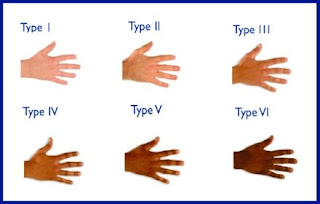
There are five basic types of skin:
1. Normal Skin.
2. Dry Skin.
3. Oily Skin.
4. Combination skin.
5. Sensitive skin.
How to determine Skin type?
To determine your skin type just wipe out your face with a facial tissu when you awake from sleep in the morning.
1. If you don't find any traces of oil in tissu & your skin feels vibrant and elastic then your skin belongs to normal type.
2. If your skin is dry, the paper will be clean, too, but your face skin will feel flaky, dry, and tight after you have wiped it.
3. If the paper will have spots of facial oil on it, corresponding to the areas of your cheeks, nose, and forehead then your skin belongs to oily type. Oily Skin is problematic - it usually looks greasy, thick and shiny.
4. If you find oil in tissu that coming from your nose and forehead but not from your cheeks then your skin belongs to combination skin just like most women.
5. Sensitive skin is usually very dry, your skin will feel tight, and becomes inflamed and irritated easily. Sensitive skin develops reddish and scaly areas.
1. Normal Skin.
2. Dry Skin.
3. Oily Skin.
4. Combination skin.
5. Sensitive skin.
How to determine Skin type?
To determine your skin type just wipe out your face with a facial tissu when you awake from sleep in the morning.
1. If you don't find any traces of oil in tissu & your skin feels vibrant and elastic then your skin belongs to normal type.
2. If your skin is dry, the paper will be clean, too, but your face skin will feel flaky, dry, and tight after you have wiped it.
3. If the paper will have spots of facial oil on it, corresponding to the areas of your cheeks, nose, and forehead then your skin belongs to oily type. Oily Skin is problematic - it usually looks greasy, thick and shiny.
4. If you find oil in tissu that coming from your nose and forehead but not from your cheeks then your skin belongs to combination skin just like most women.
5. Sensitive skin is usually very dry, your skin will feel tight, and becomes inflamed and irritated easily. Sensitive skin develops reddish and scaly areas.


No comments:
Post a Comment